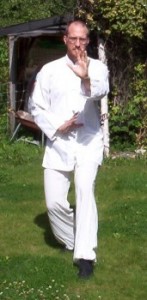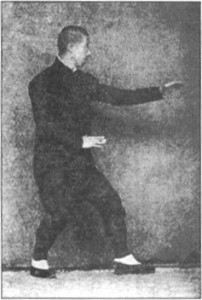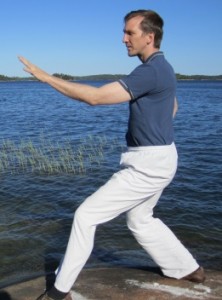 |
In Xing Yi the main standing practice is San Ti Shi –三体式 (Traditional Chinese: 三體式)
The gate to enter stillness (入靜, ru jing) lays in not doing (无为, wu wei) anything about what is experienced. There are two kinds of practice of San Ti – a static practice and a dynamic one. The dynamic one is basically moving back and forth between contracting and expanding from side to side while standing for a short time (10 breaths or so) in each posture whereas the static practice means to stand for much longer time in the San Ti posture. Sun Jian Yun recommended an hour of San Ti every day but said that her father would sometimes stand for 4-5 hours without a break. |
In “The true meaning of Martial Arts” Sun Lu Tang says: “And so it is that this boxing art is a single continuum of both internal and external. Movement and stillness have the same source. Form and function have the same method. Hence it is the case that “stillness is the fundamental form and in movement lies the function”. ” 1
The 4 postures in San Ti practise
When practising San Ti you transition between 4 postures i.e.
1. Emptiness stance (無極桩, Wu Ji Zhuang)
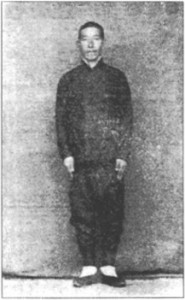 |
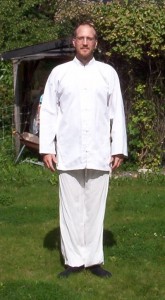 |
A study of Xing Yi Quan says:
Nonpolarity is the state you are in before commencing practice, without thoughts or ideas, without form or shape, without a sense of “me” or “him”. In the mind, all is without distinction, without intention and nothing being thought about… In the starting position, begin by facing squarely, your hands hanging down, your feet positioned at a ninety-degree angle. This posture goes along with what is natural.
Before we start to direct our intention and create we need to return to our original self, otherwise our actions will be filled with the obscurities of the everyday mind. The emptiness stance is like the “just sitting” of Zen returning to our original face before our parents were born. Sun Lu Tang speaks of this returning as Ni Yun (逆運) whereby turning the mechanism of Qi in post heaven (i.e. the manifested) one can return to pre-heaven (the non-manifested) and from there return to the original source (復出歸元).
2. One Qi stance (虛無含一氣, Xu wu han yi qi)
A study of Xing Yi Quan says:
When nothingness gives rise to a singleness of energy, it is the reversing movement of the genuine pre-heaven Qi. The singleness of energy is not a dead energy, but a lively energy, for within it there is a vitality stored, which is called innate authentic energy. It is the basis of human life, the origin of Nature, the key to creating transformation, the source of life and death. It is the foundation of Xingyi Boxing. When about to move but not yet moving, the mind is empty. One Qi is the primordial chaos (一氣渾然)
Further it says:
From the starting position, turn halfway to the right, hands hanging down, left foot in front and closing toward your right ankle until your feet are now making a forty-five degree angle. Inside, your tongue touches your upper palate and your rectum is lifted. This posture is about grasping the passive and active aspects and getting them to switch, reversing Qian and Kun, turning the energies and thus reverting to the innate true active energy in place of the acquired fake active energy that is so harmful to us.
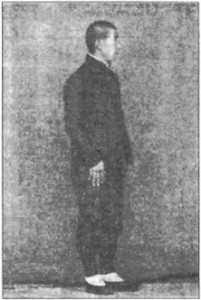 |
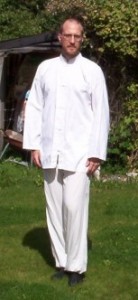 |
3. Fullness stance or Tiger Embracing Head stance (太極桩 or 虎抱头)
A study of Xing yi Quan says:
The body method in the starting position goes from stillness to motion. You must not lean forward or back, or incline to the left or right. You should be balanced and not drift away from balance, standing centered and not leaning away. Your left foot is in front, your right foot behind. Your left heel is close to your right ankle, making a forty-five degree angle, as in the photo. Your shoulders loosen and have an energy of hanging down. Your elbows are close to your ribs. Your hands cover your solar plexus, left hand below, right hand on top. Your left forefinger extends forward underneath and your right middle finger extends forward on top, covering your left forefinger, the two fingers coming together. Your head should be pressing up and your neck should be upright. Your waist has an energy of sinking down. Your hips have an energy of drawing in. Your heels have an energy of twisting outward. Your legs slowly bend downward, as in the photo. The bending of your legs should have a rounded fullness, and must not be a dead bend. Your body still must not have the slightest bit of crookedness, and there must not be the slightest bit of effort in your mind. During this starting position, your intention is to be like a vertical pole that has been placed in level ground. Once this pole starts to stand stably, your mind and energy become naturally calm and still, without inclining toward anything. It is said the mind unites with the intention, the intention unites with the energy, and the energy unites with the power. These are called the “three internal unions”. If your mind is not uniting with your intention, then being off by a hair will make you miss by a thousand miles. Therefore if you want to learn this art, you have to delve deeply.
This posture is the contraction posture which gives birth to San Ti. The contraction is performed by the five bows (arms, legs and spine). The main principle of “elbows does not leave the ribs, hand do not leave the heart” is clearly manifested as is the five characteristics of Rooster leg, Dragon body, Bear shoulders, Tiger embracing head and Eagle claw. The meaning are as follows:
1. Rooster leg: to differentiate the weight and to stand firmly, grasping the ground.
2. Dragon body: The body is folded into sections yet at the same time all united as one. Nothing is stiff but free like a dragon floating in the sky.
3. Bear shoulders: The neck is straight and has vertical power (bai hui i.e. top of the head is pressing up). Shoulders relax down so that Qi sinks to Dan Tian. Back is rounded and chest relaxed.
4. Tiger embracing head: It is like a cat catching its pray i.e. alert and yet relaxed. It is also like a tiger exiting its cave (ferocious and fearless) where the contraction is manifested as the hands embracing each other.
5. Eagle claw: The eagle catches its prey with great power in its claws but without strenuous effort. The strength of the grip is from the Dan Tian.
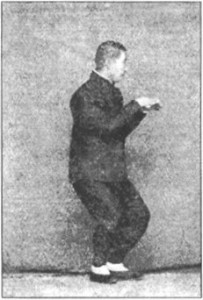 |
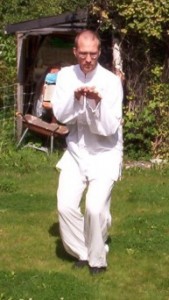 |
4. San Ti stance or San Cai Stance (三體桩 or 三才桩)
Sun Lu Tang modified the San Ti stance that Sun Lu Tang learned from Li Kui Yuan and Guo Yun Shen after traveling to Shanxi and meeting Song Shi Rong and Che Yi Zhai who both had the front palm more vertical. Sun Lu Tang felt that this way of practising was greatly conductive in developing internal energy and modified it accordingly. The original San Ti is now referred to to as San Cai Zhuang to distinguish the two. There are some other differences between the two postures as well i.e.
1. In San Ti the middle finger and Lao Gong aligns with the centre line whereas in San Cai the index finger and He Gu aligns with the centre line.
2. In San Ti the body is between straight and angular whereas in San Cai the body is turned almost 45 degrees.
3. In San Ti the weight is 60% on the back leg whereas in San Cai it is 70% on the back leg.
4. In San ti the tip of the fingers of the front hand are at the level of the lips whereas in San Cai the front hand is at the level of the heart.
A study of Xing yi Quan says:
“ When going through your practice, the myriad techniques all come out of the three-substance posture. This posture is the gateway to the method, the main tool in Xingyi Boxing.”
San Ti Shi
San Cai Zhuang
Words of 3
3 verticals
- Aligning the front knee with the heel
- Aligning the front wrist with the foot
- Aligning the buttocks with the back foot
3 Ding
- Head presses upward (xu ling ding jin)
- Tongue press up against the upper palette
- Fingers press upwards (wrist sink down)
3 Kou
- Chest (han xiong)
- Palms (ying zhuo)
- Feet (zhua di)
3 yuan
- The spine is round
- The eyes are round
- The tigers mouth is round
3 chui (三垂)
- Qi sinks down
- Shoulders drop
- Elbows drop
3 yue
- arms arc like a bow
- Legs arc making the crotch round and balancing the closing inward of the knees
- Back is rounder (ba bei)
3 kuai
- Eyes percieves quickly
- Heart is quickly moved
- Hands moves quickly
What is going on in your mind when you practice San Ti Shi?
To me the basic attitude in San Ti is Hu Bao Tou (虎抱头, Tiger embracing head). It is completely aware of what is embraced (the whole body) yet at the same time vibrantly alert and aware of surroundings. When it comes to Yinian Huodong (visualizations), I start with imagining, then once it is established i allow for more and more curiosity and investigation. This makes for a transition from “making it happen” to “discovering that this is so”.
Is there some kind of gradual progression of practise?
Yes, in a sense there is. First you need to be able to stand correctly so focus is just on correct posture. Then the investigation starts. Relax is one, whole body power (6 he), root, opposing forces, 5 charactericstics (ji tui, long shen, xiong bang, hu bao tou, ying zhuo), 5 bows, 3 dantian, 6 gates (bai hui, hui yin, 2 lao gong, 2 yong quan), 3 flows (up-down, down-up, circulating) are some examples of others. It is a dynamic balance between engagement and allowing things to happen, cultivation and natural growth.
What to do about distractions and random thoughts?
The key is interest. It begins with curiosity and that turns into interest. When there is wholehearted interest, random thoughts simply does not arise. However when this is not the case and random thoughts arises just notice that you are distracted and return to the standing practice.
- https://brennantranslation.wordpress.com/2013/04/29/the-voices-of-sun-lutangs-teachers/ ↩

